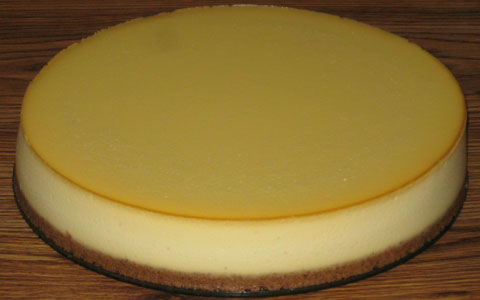|
|
 |
Baked Plain Cheesecake—Prototype 15:
3-Cheese Blend (1CT-1NC-4YG):
Prepare ahead of time 32 ounces of yogurt cheese, derived from two 32-ounce
containers (that's 64 ounces altogether) of nonfat yogurt. If the resulting
yogurt cheese falls below 32 ounces, add back enough of the whey (that was
strained out from the yogurt) to make up the difference. To this yogurt cheese
combine 8 ounces of whipped, lowfat cottage cheese and 8 ounces of softened
Neufchatel cheese ("light cream cheese").
Crust:
2 oz. melted, white chocolate
8 oz. (1 cup) 3-cheese blend (see above)
1/4 cup granulated sugar
3 tablespoons brown sugar
2 teaspoons cinnamon
1/2 teaspoon vanilla
2 oz. All-Bran, ground up
Place the resulting mixture in the greased pan and pre-bake without tub at 300
degrees for 5-10 minutes, depending on the mixture's thickness (closer to 10
minutes if thin enough to be fully distributed across the pan's bottom by gentle
shaking, closer to 5 minutes if thick enough to require spreading out this
mixture by pressing on it with a utensil and/or fingers), then cool enough to
comfortably touch at least the pan's upper sidewall.
Batter:
1 1/4 cups granulated sugar
40 oz. (5 cups) 3-cheese blend (see above)
2 teaspoons vanilla
1/4 cup + 1 tablespoon (5 tablespoons altogether) arrowroot
5 eggs
Wrap the pan in foil just before adding the batter (to minimize the foil's
disturbance and therefore its leakage risk, do not put it on any earlier).
Next, pour the batter over the crust and bake this cheesecake in a hot water tub
at 300 degrees for 120 minutes (if using a 9 1/2" pan). Then cool the
cheesecake down while still in oven (with this oven shut off) and in tub with
door slightly ajar for an hour. Afterwards, remove from oven and tub and
continue to cool down at room temperature for another 120 minutes, then remove
from pan and refrigerate.

|
|

|

